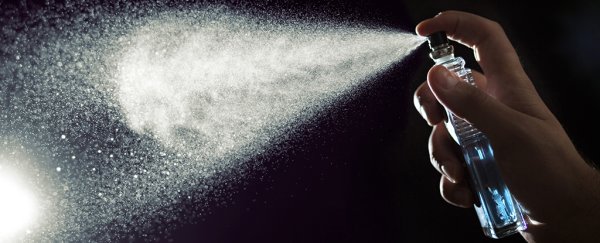In a major study released Thursday, a team of government and university scientists say that the nature of air pollution is changing dramatically as cars become cleaner.
This is leaving personal-care products, paints, indoor cleaners and other chemical-containing agents as an increasingly dominant source of key emissions.
"Over time, the transportation sector has been getting cleaner when it comes to emissions of air pollutants," said Brian McDonald, lead author of the study in Science, who works for the University of Colorado at Boulder and the National Oceanic and Atmospheric Administration (NOAA).
"And as those emissions come down, the sources of air pollution are becoming more diverse."
The study focused on a class of chemical products that give off "volatile organic compounds," or VOCs - petroleum-based odorous substances that, in outdoor air, can contribute to the formation of ozone or even dangerous small-particulate pollution.
The research found that the contribution of these chemicals to the overall burden of VOCs has been significantly underestimated and is underrepresented in current inventories used to judge the sources of pollution.
The volatile compounds in question take many diverse forms and have complicated origins, emerging from trees and grass as well as from human-made sources such as cars.
They are also found in many kinds of consumer and industrial products. The new research in particular cites "pesticides, coatings, printing inks, adhesives, cleaning agents, and personal care products" as key sources of VOCs.
In some cases - pesticides, for instance - these chemical products give off VOCs outdoors. In other cases, the emissions occur indoors and then migrate outside.
One giveaway in terms of what products are relevant, the authors said, is simply if they have a smell.
"Say somebody is inside using perfume, cologne," explains Chris Cappa, another of the study's authors and a researcher at the University of California at Davis.
"That smell eventually dissipates. And the question is, where did it go. And there's air exchange with the outside. Those odors dissipate because it's basically getting moved outside.
"It's just taking that indoor air and exchanging it with the outdoor air. It's not that hard to get things from the indoor environment outside."
McDonald and Cappa completed the research with a team of 19 others from NOAA, the National Center for Atmospheric Research, and multiple universities in the United States and Canada.
The findings do not automatically mean that the substances are dangerous to breathe indoors - the study simply does not analyze that question - but rather that outdoors, they are interacting with sunlight and other substances, and undergoing other chemical reactions that contribute to outdoor air pollution.
"What we really want to do with this study is just sort of raise the awareness, that this is now - in terms of air-quality implications, for some of these large industrialized cities - this is an important component of trying to meet these air-quality standards," said Jessica Gilman, a study author and a researcher with NOAA.
The study was based on diverse approaches - taking inventories of industrial production of products containing VOCs, sampling outdoor air data, and running models of how particles move from indoor environments to outdoor environments and back again.
Follow-up research in Los Angeles, notorious for its air-quality problems, found that the prevalence of VOCs in the air from chemical products matched the authors' estimates.
The cleaning products industry challenged the research on Thursday.
"We would caution media pundits against exaggerating the findings of research on the potential effects of volatile organic compounds (VOCs) found in many consumer products, including some cleaning products," said Brian Sansoni, a vice president at the American Cleaning Institute, an industry trade group, by email.
Sansoni noted that many cleaning products end up in water and don't ultimately produce many atmospheric emissions, something the study also noted.
"Equating the use of these beneficial products to air pollution represents unrealistic exaggerations of risks," Sansoni commented.
However, two scientists not involved in the research praised the work in comments to The Washington Post - and one implied that the regulatory implications of the work could be significant.
"I think this is a comprehensive study," Nga Lee "Sally" Ng, a professor of chemical and biomolecular engineering at the Georgia Institute of Technology, said by email.
"The authors argued that previous source apportionment studies have underestimated [volatile chemical product] emissions as sources of urban VOCs, as those studies did not include many species found in chemical products.
"Here, they constrained the emission inventory with both outdoor and indoor measurement data, as well as a more extensive chemical speciation than prior studies."
Ng argued that the work suggests that additional research will be needed to determine how much these chemicals are contributing to the formation of fine particles in the atmosphere, the most dangerous form of air pollution.
"These results have important implications for how and what emissions we regulate," said Brent Stephens, an expert on indoor air and the built environment at the Illinois Institute of Technology, also by email.
"We have traditionally focused on transportation and industrial emissions to the outdoor environment. [Volatile chemical products] are now relatively more important emission sources, and they come from both indoor and outdoor sources (and some primarily from indoor sources), although we don't regulate the vast majority of indoor environments."
Stephens noted that proposed budget cuts to the Environmental Protection Agency loom large in this context, because the agency conducts much relevant work on atmospheric chemistry and air quality.
"We typically think of outdoor air pollution as an outdoor problem," Stephens added. "But this study demonstrates (quantitatively) that it's more complicated than that."
2018 © The Washington Post
This article was originally published by The Washington Post.
